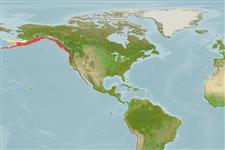Common names from other countries
Environment: milieu / climate zone / depth range / distribution range
Écologie
; profondeur 2 - 300 m (Ref. 114301), usually 60 - 120 m (Ref. 114306). Temperate, preferred 7°C (Ref. 107945); 64°N - 36°N, 179°W - 120°W
Distribution
Pays | Zones FAO | Écosystèmes | Occurrences | Introductions
Eastern Pacific: From Pribilof Islands, Alaska to Point Sur, California, USA. Temperate to boreal.
Length at first maturity / Taille / Poids / Âge
Maturity: Lm ? range ? - ? cm Max length : 28.0 cm SHL mâle / non sexé; (Ref. 95344); âge max. reporté: 15 années (Ref. 8702)
Found in small depressions on sandy-gravely substrates (Ref. 95344).
Life cycle and mating behavior
Maturité | Reproduction | Frai | Œufs | Fécondité | Larves
Members of the class Bivalvia are mostly gonochoric, some are protandric hermaphrodites. Life cycle: Embryos develop into free-swimming trocophore larvae, succeeded by the bivalve veliger, resembling a miniature clam.
Ignell, S. and E. Haynes. 2000. (Ref. 386)
Statut dans la liste rouge de l'IUCN (Ref. 130435)
statut CITES (Ref. 108899)
Not Evaluated
Not Evaluated
Utilisations par l'homme
Pêcheries: commercial
FAO - pêcheries: landings | FishSource | Sea Around Us
Outils
Sources Internet
Estimates based on models
Preferred temperature
(Ref.
115969): 0.7 - 9.6, mean 5.1 (based on 348 cells).
Résilience
Haut, temps minimum de doublement de population inférieur à 15 mois (K=0.39-0.5; tmax=15).
Vulnérabilité
Low to moderate vulnerability (32 of 100).
